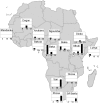Genetic evidence for archaic admixture in Africa
- PMID: 21896735
- PMCID: PMC3174671
- DOI: 10.1073/pnas.1109300108
Genetic evidence for archaic admixture in Africa
Abstract
A long-debated question concerns the fate of archaic forms of the genus Homo: did they go extinct without interbreeding with anatomically modern humans, or are their genes present in contemporary populations? This question is typically focused on the genetic contribution of archaic forms outside of Africa. Here we use DNA sequence data gathered from 61 noncoding autosomal regions in a sample of three sub-Saharan African populations (Mandenka, Biaka, and San) to test models of African archaic admixture. We use two complementary approximate-likelihood approaches and a model of human evolution that involves recent population structure, with and without gene flow from an archaic population. Extensive simulation results reject the null model of no admixture and allow us to infer that contemporary African populations contain a small proportion of genetic material (≈ 2%) that introgressed ≈ 35 kya from an archaic population that split from the ancestors of anatomically modern humans ≈ 700 kya. Three candidate regions showing deep haplotype divergence, unusual patterns of linkage disequilibrium, and small basal clade size are identified and the distributions of introgressive haplotypes surveyed in a sample of populations from across sub-Saharan Africa. One candidate locus with an unusual segment of DNA that extends for >31 kb on chromosome 4 seems to have introgressed into modern Africans from a now-extinct taxon that may have lived in central Africa. Taken together our results suggest that polymorphisms present in extant populations introgressed via relatively recent interbreeding with hominin forms that diverged from the ancestors of modern humans in the Lower-Middle Pleistocene.
Conflict of interest statement
The authors declare no conflict of interest.
Figures




Similar articles
-
Global genetic variation at OAS1 provides evidence of archaic admixture in Melanesian populations.Mol Biol Evol. 2012 Jun;29(6):1513-20. doi: 10.1093/molbev/msr301. Epub 2012 Jan 16. Mol Biol Evol. 2012. PMID: 22319157
-
Model-based analyses of whole-genome data reveal a complex evolutionary history involving archaic introgression in Central African Pygmies.Genome Res. 2016 Mar;26(3):291-300. doi: 10.1101/gr.196634.115. Epub 2016 Feb 17. Genome Res. 2016. PMID: 26888264 Free PMC article.
-
Identification of African-Specific Admixture between Modern and Archaic Humans.Am J Hum Genet. 2019 Dec 5;105(6):1254-1261. doi: 10.1016/j.ajhg.2019.11.005. Am J Hum Genet. 2019. PMID: 31809748 Free PMC article.
-
Searching for archaic contribution in Africa.Ann Hum Biol. 2019 Mar;46(2):129-139. doi: 10.1080/03014460.2019.1624823. Epub 2019 Jun 26. Ann Hum Biol. 2019. PMID: 31163991 Review.
-
Archaic hominin admixture and its consequences for modern humans.Curr Opin Genet Dev. 2025 Feb;90:102280. doi: 10.1016/j.gde.2024.102280. Epub 2024 Nov 21. Curr Opin Genet Dev. 2025. PMID: 39577372 Review.
Cited by
-
Higher levels of neanderthal ancestry in East Asians than in Europeans.Genetics. 2013 May;194(1):199-209. doi: 10.1534/genetics.112.148213. Epub 2013 Feb 14. Genetics. 2013. PMID: 23410836 Free PMC article.
-
The history and evolution of the Denisovan-EPAS1 haplotype in Tibetans.Proc Natl Acad Sci U S A. 2021 Jun 1;118(22):e2020803118. doi: 10.1073/pnas.2020803118. Proc Natl Acad Sci U S A. 2021. PMID: 34050022 Free PMC article.
-
No Country for Oldowan Men: Emerging Factors in Language Evolution.Front Psychol. 2019 Jun 19;10:1448. doi: 10.3389/fpsyg.2019.01448. eCollection 2019. Front Psychol. 2019. PMID: 31275219 Free PMC article. Review.
-
Pan-Africanism vs. single-origin of Homo sapiens: Putting the debate in the light of evolutionary biology.Evol Anthropol. 2022 Jul;31(4):199-212. doi: 10.1002/evan.21955. Epub 2022 Jul 18. Evol Anthropol. 2022. PMID: 35848454 Free PMC article. Review.
-
The impact of whole-genome sequencing on the reconstruction of human population history.Nat Rev Genet. 2014 Mar;15(3):149-62. doi: 10.1038/nrg3625. Epub 2014 Feb 4. Nat Rev Genet. 2014. PMID: 24492235 Review.
References
-
- Coppa A, Grun R, Stringer C, Eggins S, Vargiu R. Newly recognized Pleistocene human teeth from Tabun Cave, Israel. J Hum Evol. 2005;49:301–315. - PubMed
-
- Grün R, et al. ESR and U-series analyses of enamel and dentine fragments of the Banyoles mandible. J Hum Evol. 2006;50:347–358. - PubMed
-
- Morwood MJ, et al. Archaeology and age of a new hominin from Flores in eastern Indonesia. Nature. 2004;431:1087–1091. - PubMed
-
- Stringer C. The origin and dispersal of Homo sapiens: Our current state of knowledge. In: Mellars P, Boyle K, Bar-Yosef O, Stringer C, editors. Rethinking the Human Revolution. Cambridge, UK: McDonald Institure for Archaeological Research; 2007.
Publication types
MeSH terms
LinkOut - more resources
Full Text Sources

